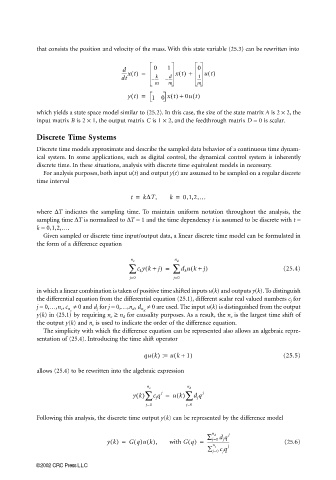Page 804 - The Mechatronics Handbook
P. 804
0066_Frame_C25 Page 3 Wednesday, January 9, 2002 7:05 PM
that consists the position and velocity of the mass. With this state variable (25.3) can be rewritten into
d
-----xt() = 0 1 xt() + 0 ut()
d
k
1
dt – ---- – ---- ----
m m m
yt() = 10 xt() + 0ut()
which yields a state space model similar to (25.2). In this case, the size of the state matrix A is 2 × 2, the
input matrix B is 2 × 1, the output matrix C is 1 × 2, and the feedthrough matrix D = 0 is scalar.
Discrete Time Systems
Discrete time models approximate and describe the sampled data behavior of a continuous time dynam-
ical system. In some applications, such as digital control, the dynamical control system is inherently
discrete time. In these situations, analysis with discrete time equivalent models in necessary.
For analysis purposes, both input u(t) and output y(t) are assumed to be sampled on a regular discrete
time interval
t = k∆T, k = 0,1,2,…
where ∆T indicates the sampling time. To maintain uniform notation throughout the analysis, the
sampling time ∆T is normalized to ∆T = 1 and the time dependency t is assumed to be discrete with t =
k = 0,1,2,….
Given sampled or discrete time input/output data, a linear discrete time model can be formulated in
the form of a difference equation
n c n d
∑ c k yk +( j) = ∑ d k uk + j) (25.4)
(
j=0 j=0
in which a linear combination is taken of positive time shifted inputs u(k) and outputs y(k). To distinguish
the differential equation from the differential equation (25.1), different scalar real valued numbers c j for
≠ 0 are used. The input u(k) is distinguished from the output
j = 0,…,n c , c n ≠ 0 and d j for j = 0,…,n d , d n
c d
y(k) in (25.1) by requiring n c ≥ n d for causality purposes. As a result, the n c is the largest time shift of
the output y(k) and n c is used to indicate the order of the difference equation.
The simplicity with which the difference equation can be represented also allows an algebraic repre-
sentation of (25.4). Introducing the time shift operator
qu k() := uk + 1) (25.5)
(
allows (25.4) to be rewritten into the algebraic expression
n c n d
yk() ∑ c j q = uk() ∑ d j q j
j
j=0 j=0
Following this analysis, the discrete time output y(k) can be represented by the difference model
n d j
∑ j=0 d j q
yk() = Gq()uk(), with Gq() = -------------------- (25.6)
n
c
∑ j=0 c j q j
©2002 CRC Press LLC

